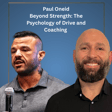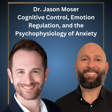Introduction to Stress Resiliency
00:00:00
Speaker
Today we're going to discuss stress resiliency, what what it means to be stress resilient. Is there a way we can build it up? What are some of the tools that we can use to become more resilient towards stressful situations. So first, the idea of stress resiliency is, um it's the ability to maintain or quickly recover mental health during or in after periods of adversity. So a lot of people think of stress resiliency as something that can be manufactured through um hard work and and exercise, and that makes you a more resilient person. and And although there is some research to kind of back that idea
00:00:39
Speaker
and And then that's something that we'll talk about
Stress Resiliency: Traits and Research
00:00:41
Speaker
within this episode. But what we also want to focus on is um some of the more cognitive, um emotional regulation type of strategies that seem to be more effective to make someone more resilient towards stress. And first, we want to think about um how do people look at stress resiliency how do they determine it within the research what are some of the ways that they research it and we have these two um trains of thought when it comes to resilience so we have this idea that it's a a trait based um manufactured idea right where the personality is based in resiliency and it's seen as like a stable personality characteristic
00:01:22
Speaker
an intrinsic trait um that can predispose somebody to handle and stress more effectively. So you can think about that as like something that's, uh, born into through genetics, temperament or personality factors. And, and there's a lot of really good research to show that, um, people that are more high in conscientiousness, uh, industriousness and things like that are going to be more stress resilient.
00:01:45
Speaker
Uh, people that are low in neuroticism will have a tendency to be more stress resilient, but the idea that those things are not something that we can, um, we can we can adjust, we can manipulate, um we can manufacture, right? These are just the flip
Outcome-Based Stress Resiliency
00:02:01
Speaker
of the coin. we either get lucky or we don't.
00:02:04
Speaker
And that's not something that we really wanna touch on. And there are some things and there's some meta-analysis and there's some really good research that touches on that. But we we really wanna focus on the other side of what it means to be stress resilient. And that's like this outcome-based approach.
00:02:19
Speaker
And that is where resilience is viewed as a result, right? It's the ability to maintain um that mental health ah or recover from it. and And an idea would be that we have we have two individuals um going into combat and they experience the same traumatic event, but but one develops PTSD ah while the other one does not.
00:02:40
Speaker
And the one who does not develop PTSD is considered you know more resilient based on the outcome of them not having that. And what are some of the key characteristics of the people that ah tend to have these traumatic events but do not suffer from PTSD?
00:02:56
Speaker
What the research shows is that there's you know within within the idea of traumatic events, typically one third of the people that suffer from traumatic events get PTSD.
00:03:07
Speaker
um So there's two thirds that that don't. and And we want to figure out kind of why that is. And how can we bolster that in everyone? How can we improve everyone's ability to um deal with stressful situations? What are some protective factors?
Interventions to Build Resiliency
00:03:23
Speaker
And that's the things that we're going to look at within this within this podcast episode. And it's it's important to understand why this distinction matters, because Like I said, one is something that we're just born into. it's ah it's a It's a flip of the coin. We get lucky and that's great and we can still bolster it. But what do we do with those people that are are suffering due to high levels of neuroticism, things that that are out of their control? And and how can we think about creating interventions to create the outcome that builds more resiliency? So we can look at things like therapy, training, exercise, diet, social interventions.
00:04:03
Speaker
things like that and when we think about the traits concept of it right we're thinking about like early life development um and targeted therapies focusing on false from protective personality traits and that's going to be a little bit harder to move the needle on and and for the people that are listening to this episode um we're more in that area where we're outside of that early life development and we need to focus on what we can do now what we can move the needle on on now So understanding that there's these two dynamics and and one of them um is something that we're we're really going to focus on is is how can we improve the outcomes measures, right?
Evolutionary Perspectives on Resiliency
00:04:43
Speaker
And what is why is stress resiliency important? What is some of the human adaptability um for it? And that's one of the things we always want to think about when it comes to human nature and why we do the things that we do.
00:04:55
Speaker
um From an evolutionary perspective, we have this unpredictable and hostile environments and We're always constantly um inundated with these threats to survival, reproduction, and in well-being, and the successful people are able to adapt to those stressful environments. And that's why continues to get passed down as something that is looked upon a higher up in the in the hierarchy, right? When we see people that can cope and deal with stress, we tend to think of them as, you know, super um stoic, resilient people that can really handle anything that life gives at them. And we we put them on ah on a bit of a pedestal.
00:05:33
Speaker
And, you know, that's something that we want to, from an evolutionary perspective, it makes a lot of sense. And those are the people that we want to kind of build around and and circle around so that we know that they're going to survive no matter what's going on, where you have the other people who have these traumatic experiences and they tend to be um affected by long
Resilience Mechanisms and Processes
00:05:56
Speaker
term. And you can see how from an evolutionary perspective that can be very detrimental to the um product productivity of the of the tribe of of even of that person not being able to cope and and understand
00:06:07
Speaker
um how we can become more adaptive and and why that can be a problematic thing. and so the the current approach is, you know how can we how can we make these observable?
00:06:19
Speaker
What are some of the things that we're gonna look for within the research? They look for resilience factors and they look for resilience processes within the research. right So resilience factors are these predictive variables that contribute to resilience and they include these malleable um factors such as social support, emotion regulation skills, and then these stable factors, um which are the personality traits, the genetics, the brain structures, and things of that nature. then we have these resilience processes, and that's the improvement of these factors over time.
00:06:51
Speaker
And they do longitudinal studies to to track this type of stuff so we can really see it. So learning new emotion regulation strategies in response to adversity helps prevent that long-term mental health issues. And we can track introducing these factors Emotion regulation strategies and then seeing how people observe ah observe them how they overcome stress and and how they react to that and they've there's some beautiful studies that we'll get to within this episode kind of going over it um and we want to also look at resilience mechanism right um what is the the mental bodily behavioral processes that help individuals cope with stress and improve their long-term resilience
00:07:32
Speaker
um So an example of that is if a person actively seeks support during stress, that specific act of seek and help is what we would call a resilience mechanism.
00:07:43
Speaker
And then the resilience factors are the predispositions, conditions that make it more likely that an individual will activate um these resilience mechanisms. So we have intra-individual ones, cognitive skills, ah neurobiological traits, and then we have the extra individual ones, social support, parenting style,
00:08:03
Speaker
um An example of that would be a person with strong communication skills, which would be at that intra-individual resilience factor. um In a supportive environment, which is that external ah resilience factor, is more likely to seek help when when stressed.
Adaptive Stress Responses
00:08:18
Speaker
and So those are things that um we want to look at in terms of how can we make those stronger within our communities, within ourselves, and how how we can move forward from there. And then we have the resilience processes and then like the long-term adaptation to that.
00:08:34
Speaker
And the processes are these factors that change over time improving our ability to to cope with stress. um A person experiencing adversity may improve emotion regulation skills such as cognitive reappraisal, um which we've talked about in previous episodes, and that can strengthen those resilience factors. And we have these short-term acute responses that can be very helpful, such as when things are highly stressed, ah distraction or avoidance can be very beneficial.
00:09:06
Speaker
um Whereas the if the stress response is low and muted, then something like cognitive reappraisal may be more beneficial in that instance. And then we have the long-term ones, um things that we have these toolboxes and we we have all these tools that we can pull from that help with long-term resilience.
00:09:27
Speaker
So we want to think of it in terms of um multi-level framework, right? Resilience mechanisms, resilience factors, and resilience processes. And how can we build those through the short-term and the long-term?
00:09:40
Speaker
Someone who successfully seeks help during stress, that's that resilience mechanism. And we, and and within that, they may develop a stronger tendency to so seek to seek support in in the future.
00:09:52
Speaker
and So we have this constant reward processing of we sought out help during stressful situations that helped lessen that stressful situation. So therefore, we're building this model, right this error prediction model of like this was a successful step in the right direction.
00:10:12
Speaker
um So something else to to think about is this, you know, the the the universality of resilience mechanisms, right? We're going to go over some of these and you'll notice that some may work for you and some some may not. There's <unk> no such thing as a a universal coping strategy that's going to work for everyone.
Stress Response Systems
00:10:33
Speaker
and we want to make sure that we're able to pick the ones that work for us and we want to try to use as many at ah at our disposal and there'll be some that we go over that um are adaptive in certain situations and and maladaptive if we continue to push them and and use them to um process all of our stress situations there's not a one-size-fits-all cognitive reappraisal is great but it's not going to be the one that always gives you the answer that you're looking for So we have stress, right? And that's an adaptive function. We want things to be stressful in our life. We want to create stress in our life through exercise, through doing challenging things, trying to constantly trying to push our body to to adapt.
00:11:18
Speaker
and that's where that stress response comes in and in acute bouts that's going to be very beneficial for us um and it involves the cognitive um attentional seeking problem solving planning and then the emotional complexity feelings of anger and anxiety um and then the behavioral the active coping efforts biologically right we have the stress response that is um activated within the brain and it first goes through the um Sympatho adrenal medullary system, right, the SAM system, and that involves the adrenal release.
00:11:55
Speaker
um So you think of the glucocorticoids and the things that are released through the adrenal gland. And then we have the HPA axis, the hypothalamic pituitary ah adrenal axis.
00:12:06
Speaker
and that leads to that that cortisol response, right? So have the glucocorticoids that get released, and then that manifests itself into the brain, into the HPA axis, and then that releases
Coping Strategies and Stress Intensity
00:12:17
Speaker
And we want those adaptations to be a very acute in nature, but as soon as they become chronic, then we get dysregulations and then we get things that are not necessarily shown in the research to have scientific validity such as like adrenal fatigue um but we do know that there are we can think of it as not so much adrenal fatigue but just a depletion of our adrenal response to um Schiffernitz, when it when it's supposed to be released it'll continue to to do that and it'll start to to drain its ability to be functional and that can create dysfunction within both those accesses.
00:12:58
Speaker
um So in the short term, like stress mobilizes all our resources so that we're able to handle threats. Very good thing. um But it becomes harmful when it's chronic or exaggerated and it consumes resources and leads to ah dysfunction and disease.
00:13:14
Speaker
But we want to make sure that we're not actively always avoiding stress. um Because that doesn't create that resiliency. That doesn't allow us to learn the mechanisms to cope with this type of stuff. We want to learn strategies to to do it. And again, sometimes in high stressful situations, of the research tends to indicate that avoidance and distraction may be a better option every now and then um just to get away from the situation.
00:13:42
Speaker
But it's not the strategy that we should use um every single time. And because that's when we start to run away and focus on avoiding things that need to be um something that we seek head on, right? We want to seek challenging things. We want to seek things that ah force that cortisol response. But we want to be able to control those things so that when they get put upon us in situations that we can't control, we're able to use these strategies to manipulate our our responses and um pull us from a sympathetic drive to a more parasympathetic state so that we can help regulate that autonomic nervous system and and get cortisol in our body regulating itself and acting appropriately.
00:14:26
Speaker
So not all coping strategies are helpful in all situations. It's an good idea to have flexibility within our ability to cope with stress.
00:14:37
Speaker
So examples of that would be, you know, for using effective um help seeking, right? That can be when support is available, that can be very effective. But if that's our only strategy, it can be a little unreliable.
00:14:50
Speaker
um It can cause dependency issues when people aren't around. So then we can start to fall into this idea of nobody's here for me. Nobody's there when I actually need them. And if that's our only tool that we can pull from, then that can cause problems. Same thing as fighting an aggressor, right?
00:15:09
Speaker
It's great if we win the fight, but it can be very harmful um in unsafe situations. So if we if that is our tendency to cope with stressful situations is to like attack it head on, that can be very problematic in places where that's not necessarily the the safest choice. And then the the last example is distraction, right? it can be good.
00:15:29
Speaker
um when no action can be taken so like think of turbulence on a plane if it's can be far better to distract ourselves because well it's out of our hands right so it's the locus of control we want to focus on the things that we can focus on um but it could be harmful when immediate action is needed right if we're distracting ourselves when we have this negative external stimulus coming at us uh it's going to punch us in the face and we're too busy distracting ourselves to actually be able to make the decisions in order to avoid those negative situations
00:16:02
Speaker
So we want to recognize the nature of the stressor. We want to select the most effective strategy for each situation, and we want to monitor its effectiveness, and we want to switch strategies when necessary.
Flexible and Adaptive Stress Responses
00:16:15
Speaker
So we're always constantly thinking about how can we and Deploy these strategies and then we're also thinking, did this one work in this situation or was this a negative adaptive situation for for the strategy that I use and what's a what's possibly a better strategy that I i can do moving forward.
00:16:34
Speaker
So the core idea is to have this flexible and adaptive response to stressors, depending on how individuals appraise slash interpret the the stressful situation.
00:16:45
Speaker
um So when a person is overwhelmed by negative emotions, they can struggle to select rational, flexible coping strategies. um So that's when you get this flooded, right? you get So think of like an argument with a significant other and you get flooded with all these emotions you start to realize like my ability to say the thing that I want to say to get my point across is now blurred with this emotional response that I just can't seem to use the right words or, you know, put myself in the right situation to make the right um gestures, right? We get flooded with these emotions and um that can make it very hard. But the more you practice it, the more it becomes automatic. So these are things that are, you know, tangible tools that we want to practice over and over again.
00:17:30
Speaker
So within the idea of like a good mechanism is is appraisal, right? Appraisal processes occur before an individual selects say a coping strategy. So they're both conscious and non-conscious. The conscious verbal appraisals is how we actively think about the stressor and then the non-conscious ones are these automatic and instinctive responses right those are the emotions non-conscious automatic and then we have the feelings which are conscious verbal appraisals and we've talked about that in previous episodes the ability to reappraise things from a negative to trying to find a positive approach to that
00:18:10
Speaker
Dr. Justin Marchegiani So a very important thing note, and to thing note.
00:18:24
Speaker
um more robustly so The resilience factors, a key is appraisal biased towards positivity.
Optimism and Positive Memories
00:18:35
Speaker
um Individuals with mild optimism, appraisal tendency or tend to have a more resilient, more robustness in their resiliency. So slight optimism allows us to put ourselves in a more of a positive state of mind when negative stimuli comes about.
00:18:56
Speaker
So threat probability would be like mild optimism. um You know, rather than expecting the worst, we can expect some good from things, right? So if you're going on a date, instead of thinking like, oh, man, this person's not going to like me, this person's going to think that, you know, I'm not funny, and you have all this this negative skepticism going into it, right? Having some mild optimism of like, oh, yeah, you know,
00:19:20
Speaker
this person's gonna like me because you know every interaction that i've had over the last three months have been positive interactions and and no one's said to my face you know that hey like i don't like you you're not worth talking to but so we can use past experiences to shape our optimism of future experiences and current experiences as well And then another way optimism can help is through um the magnitude of the threat. It can help.
00:19:47
Speaker
we can We can use mild trivialization rather than catastrophizing and controlling power, right? We can have mild overconfidence rather than helplessness.
00:19:58
Speaker
And that can increase our motivation to act towards things, right? This idea of like, Mild confidence, being confident in things that you've never done before usually results in better outcomes.
00:20:13
Speaker
So if you're going to play pickleball with your friends and you never played before, Having some confidence in your athletic ability is usually going to result to more competency and more fun when you start to play the game as well, as opposed to just thinking that, you know, like, oh, man, I always trip over my feet.
00:20:31
Speaker
And that's just the type of person I am. So when I go to play, I'm going to trip over my feet. I'm going to get embarrassed. No one's going to want to pick me again. So like, why even bother showing up? So we wanna start to think about like, how can we reinterpret some things through a more optimistic lens? That's one of the um primary strategies and primary tools to help build more resiliency. It's a reshaping and a reframing of the way that we look at ourselves and the way that we look at the challenges in in front of us.
00:21:00
Speaker
um And then, like I said, we even learn from past experiences. We can use our ability to have this flexible theory of mind of, you know, If I have a hard test coming up, I've gotten A's on all my other tests before. So if I follow the same strategies that I use to get A's, I should have another A on this one as opposed to, you know oh man, this one's gonna be more difficult. This one's gonna be more complex. I'm not goingnna be a good i'm not a good student, so therefore I'm gonna i'm gonna fail.
00:21:29
Speaker
ah So we want to use past experiences to begin to shape and positively reappraise um over time. And we also know that that starts to begin to store memory, positive memory enneagrams in our mind that we are the successful person, that we are constantly forming these new memories. And if we're using an optimistic lens to form those memories, then we're going to be able to pull back on those and look at those from time to time in order for us to update our ability to be successful in stressful situations. One of the things that people who suffer from depression have a hard time with is they start to store more negative memories and they're not able to enlist any positive memories. and we've seen through the research of optogenetics and other research where they were able to implant positive memories, at positive enneagrams in the memory stores of of mice.
00:22:25
Speaker
that the mice automatically instantly went from a depressive symptoms to a more positive um outlook and positive symptoms. um So the memories that we form, the way we we optimistically view things is going to start to update old memories and negative memories.
00:22:42
Speaker
So we want to, you know, that we want to be able to regulate our stress through optimism by shifting the way that we look at things and how we view ourselves in the world. And then that's going to create more positive experiences. We're going to store those as memories. And then then for we're going to have stronger resilience over time.
00:23:01
Speaker
Another one is this idea of fear and and threat and being able to discriminate between um threat and and safety. And the research on this where they do these fear exposures is another way that we can build um stress resiliency in
Fear Exposure Techniques
00:23:20
Speaker
people. So if you're... um if you're scared of, say, spiders, right, what they've shown in the research is that we can slowly introduce this thought of spiders and slowly introduce um the the picture of spiders and then slowly introduce the actual spider to the person to where each individual step allows that person to realize that this is no longer a threat.
00:23:44
Speaker
And I'm in a safe environment, right, but we want to be able to create those safe environments every single time. So if you're thinking about A real world situation where that can come into play is you know, if you're trying to teach someone how to play a sport, if you throw in the most complex movement um that's in that sport in the very beginning, and they're not able to pick it up right away, that's going to create this idea that I'm incompetent at the sport, I can't play this sport, therefore, it's going to be a quote unquote, a threat.
00:24:14
Speaker
Right. And they're not going to feel safe in this environment where if you slowly inundate them with skills that are are slightly challenging, but they can still accomplish, they're going to start to build competency, self-efficacy, and you you're slowly making it more complex over time.
00:24:30
Speaker
And that helps blunt that that fear response. um So even though it's not a spider or fearful situation, these same adaptation principles can be displayed and can be used when um teaching a skill.
00:24:43
Speaker
when trying to learn something new, when trying to um shift the way that you perceive negative stimuli. So if you go and you think to yourself like, oh man, every time I go out my friends, I always bumble over my words and they're just not going to want to hang out with me anymore. have this fear that every time I go out, I just bonk and it's not good. right Well, you can slowly work your way into um talking to a friend one-on-one and then understanding that, okay, this person, you know, wants to hang out again.
00:25:15
Speaker
And then you can go to maybe two people, and then you can go to three, and then you can go to bigger groups. And then you'll start to slowly realize that the threat, this idea of this um cynical approach to the way we look at things um is not actual fact is not actually factual. So we can start to distinguish or extinguish that fear response um by slowly inundating ourselves and The reason why that is important for for stress resiliency is that people who have strong resiliency show better abilities to have that extinction learning and memory response.
00:25:52
Speaker
And the ones that are prone to anxiety disorders such as PTSD, often have that impaired extinction learning, meaning that they continue to fear stimuli that are no longer threats.
00:26:03
Speaker
and So it has a dysregulation and by slowly inundating ourselves to fearful situations and given ourselves positions where we come out with a idea that this is a safe environment, we can slowly begin to have a more robust ability to extinguish our fear response and create those memories in order for us to be successful in in any situation um that may have been fearful and in the past.
Cognitive Behavioral Techniques
00:26:33
Speaker
So another idea is the stress reactivity and recovery ah paradigm and the the goal ah The goal of that is like, how do we respond and recover from stress? And that's how they ah implement these studies to to figure out ways to to do that. So a participant faces a acute stress like public speaking and then the The researchers measure the reactivity, like how intense is this response and then how quickly they return to baseline.
00:27:06
Speaker
We do that within our research when we're trying to use cognitive behavioral therapy techniques to improve performance in in um certain conditions.
00:27:17
Speaker
resistance exercise or aerobic exercise and we track hrv in order for us to see the the stress response and to see the recovery dynamic of it and then we can implement different cbt strategies during exercise after exercise to see if we get better responses um and they found that resilient individuals ah recover faster from stress and those with high vulnerability, um such as anxiety disorders show slower recovery. And that's because you have this constant um autonomic nervous system shift towards more sympathetic arousal. they're more They're in a more sympathetic state most of the time
00:27:54
Speaker
and they're not able to pull back down to that parasympathetic state so through like an hrv perspective um they tend to be more in that their high frequency to low frequency ratio is is thrown off and it's it's lower and they've shown that hrv and those ratios that are lower at baseline tend to be more problematic for people with depression and anxiety and we know throughout the research that in in order to prove improve HRV. We can do that through breath work. We can do that through aerobic exercise.
00:28:24
Speaker
So there are some levers to pull in order for us to improve that resiliency. um But we wanted to, we want to test those things and and see if we can do that.
00:28:35
Speaker
So then beyond the intensity duration of the response, that's going to allow us to know which coping strategy is the best for us. And one of the one of the tests that they use within the research was developed by Sheeps et al. And they studied how people chose choose coping strategies based on stress intensity. This is something that I touched on earlier and the experiment, they did three of them and they found that participants were presented with emotional pictures ah that varied in intensity. So you had high ah intensity arousal pictures and low intensity arousal pictures.
00:29:13
Speaker
So you can think of like a picture of somebody yelling or fighting or um something that's a fear response to them that can be a high intensity, whereas like a puppy or somebody hugging can be more of a low intensity one.
00:29:29
Speaker
And what they did was ah before viewing each picture, participants were informed about its intensity level, and then they were asked to choose between emotion regulation strategies. And the two that they used were distraction and reappraisal.
00:29:43
Speaker
And what they found was when intensity was extremely high, ah distraction tended to be the strategy that they used the most and was actually the most successful. And reappraisal is better to be used when the intensity is a little bit lower.
00:29:59
Speaker
And the reason for that is because they're able to, um so when you are distracted, you get that flood or you, when you have that high intensity, you get that flooded response.
00:30:10
Speaker
And sometimes when you get that flooded response, we're not able to activate our prefrontal cortex and the prefrontal cortex is where We're able to do cognitive reappraisal.
00:30:20
Speaker
So we need that lower intensity stressor in order for us to get into our prefrontal cortex. So the great thing about distraction and high intensity is we're able to pull ourselves away from that situation. We're able to reduce that stress response so that we can start to use the prefrontal cortex again.
00:30:38
Speaker
um So when you get in those high intensity situations, like a fight with your significant other, sometimes it's best to pull away from that. Take five minutes, take a five minute break, ah use some type of distraction word that you and your significant other have already talked about that makes you guys laugh, that makes you guys understand that, hey, like,
00:30:57
Speaker
This is just a little, a little argument that we don't need to take it too seriously. um so those distraction techniques allow you to pull back from that emotional response so that you can start using your um prefrontal cortex again to make those appropriate decisions.
00:31:15
Speaker
And then with the cognitive reappraisal, right, anytime there's low intensity stimuli, right, we can really begin to shape that idea of, hey, this is, this doesn't feel great right now.
00:31:27
Speaker
um But I know, so exercise is a great example, and this is something that we did within within our lab. is that whenever people were having negative responses to cycling to exhaustion we had them shift their mindset so one thing would be boredom as you can imagine people on a cycle ergometer with no music no distraction no no anything um boredom is going to be one of the biggest things that's going to make people stop before they're actually physically exhausted so we started to use cognitive reappraisal to shift their mindset from
00:32:02
Speaker
Hey, this is this is boring. So whenever that feeling of boring comes up, because that's an automatic response, that's just not something that we can't control. They start to shift that to, hey, this is a very challenging experience.
00:32:13
Speaker
I'm the type of person that leans into challenging experiences. So I'm going to keep pushing through this boredom. I'm going to be that person that is able to overcome boredom. And we started to use those ideas inside. And what we saw within our research is that not only did that improve their performance on time to exhaustion compared to ah the control group, but it also improved their depression scores and their um intrinsic motivation scores as well.
Fear and Reward Systems in Resilience
00:32:40
Speaker
So these are things that we can begin to use to to shift not only through exercise, but through um other instances of high stressful and low stressful situations so that we can reappraise or distract ourselves and then reappraise afterwards.
00:32:58
Speaker
So one of the big things within stress resiliency is we have the the reward paradigms as well, right? So the reward system um is an antagonist to the aversive system.
00:33:10
Speaker
So we have fear learning and reward learning, they compete in the brain, they're constantly going at it, positive emotion inhibits negative emotions and and vice versa. So fear extinction learning relies on on dopamine, which plays a key role in reward learning.
00:33:24
Speaker
And the role of dopamine in fear extinction has been increasingly recognized due to its involvement in prediction error processing, which we talked about that prediction error is what our our memory does on a constant basis. And also plays a huge role in in salience attribution, like what do we pay?
00:33:42
Speaker
What is our attention focused on and reinforcement learning? um So yeah. The idea of fear extinction is that it's not passive forgetting, but rather active learning um through processes where an individual learns that a previously feared cue no longer predicts danger.
00:34:01
Speaker
And dopamine plays a central role in encoding prediction errors, particularly through the activity of the ventral tegmental area, the VTA. So the prediction error, we have a negative prediction error, what an expected aversive outcome, think of like a shock, when it does not occur, the brain detects this discrepancy.
00:34:20
Speaker
So then the positive prediction error is when an unexpected positive outcome, such as safety when danger is expected. So you you expect a shock and you don't get the shock, instead you get rewarded, that's a positive prediction error.
00:34:35
Speaker
And then during fear extinction, dopamine signals the absence of expected punishment and reinforces this new learning that stimulus is is now safe. And studies show that um by blocking dopamine signaling, that impairs extinction learning and prevents animals from properly updating their fear response.
00:34:56
Speaker
So we have these overlapping circuits within the dopaminergic area um that play integral roles with reward and extinction and and what you'll know within What you'll come to learn within the brain is that there's no one brain area that doesn't, everything is intertwined and everything plays off of each other.
00:35:14
Speaker
So dopamine is is known for its reward-based learning where it reinforces behavior um that leads to positive outcomes. It can also lead to negative outcomes.
00:35:24
Speaker
So we have people that are trying to diet and they're constantly show chasing reward-based food. that's gonna reinforce this negative behavior. So when the diet gets hard or say they get stressed out in life, um that's when people have a tendency to fall off their diet because they're looking for a coping strategy and they're looking for a reward for a stressful situation. And therefore they seek food um that allows them to create more dopamine so they feel more positive, um but that's more of a negative cycle that they can get into. So it can be both positive and negative.
00:36:03
Speaker
But the fear fear extinction, it recruits the same um pathways involved in reward learning. So the ventral tegmental area, the VTA um and the nucleus accumbens circuit is crucial for reinforcing behaviors that lead to safety.
00:36:22
Speaker
So the the VTA to the pathway is the dopamine to the nucleus accumbens pathways, the dopamine circuit when organisms experiences relief or reward ah so it can be dopamine released in the nucleus accumbens during fear extinction enhances the encoding of that new safe memory and therefore we can continue to update and update And it also plays a significant role in the prefrontal cortex and the amygdala, which we touched on a little bit already.
00:36:54
Speaker
And the prefrontal cortex, specifically the medial one, is crucial for extinction learning as it regulates inhibitory control over the amygdala. So as you can imagine, if the prefrontal cortex is not working as well due to traumatic injuries, which we've seen a lot, um that can inhibit or that can not that can ex that can create a um non-inhibitory uh control over the amygdala so then if if that's the case the amygdala is responding and instead of the prefrontal cortex inhibiting it it's allowing it to run free and create more negative stimuli more negative response more native response so we need the prefrontal cortex it's a crucial role in our ability to inhibit inhibit that fear response
00:37:42
Speaker
and the dopamine, the D1 receptor particularly is activated in the infralimbic cortex, which enhances extinction recall by strengthening inhibitory connections from the prefrontal cortex to the amygdala and the basal lateral amygdala and the central amygdala are critical for fear learning and extinction. So dopamine releases in the BLA during extinction And that modulates plasticity, allowing for formation of new safety associations.
00:38:13
Speaker
So we need that prefrontal cortex to be able to to help regulate some of that amygdala response.
Executive Functions and Memory Tasks
00:38:20
Speaker
and we have this individual differences between dopamine so people with high anxiety disorders such as ptsd often exhibit impaired fear extinction which is linked to altered dopamine signal too little dopamine activity in the prefrontal cortex and the nucleus accumbens is associated with poor extinction learning and resistance to update in fear responses too much dopamine in the amygdala is associated with persistent fear responses
00:38:45
Speaker
So where that dopamine is being released and where those connections are, the strongest is going to be what we're trying to use um in order for us to predict what's what's the dysregulation within the brain.
00:38:59
Speaker
So some cognitive control paradigms that we want to think about is reappraisal strategy selection and then suppress unhelpful emotional reactions. And the three keys to those executive function um is inhibition, which is suppressing unwanted emotional reactions.
00:39:16
Speaker
Selective attention to filter out unnecessary stress-related stimuli, um the constant ability to update and rework our our work in memory, holding emotional information in mind while adjusting responses, and then that cognitive flexibility, that's switching between different coping strategies as needed.
00:39:36
Speaker
So again, we talked a little bit about memory and the the long-term episodic memory and how that can be um shifted. ah People with better memory specificity can more accurately evaluate threats, right? And older adults tend to store experiences in a more generalized manner, which is efficient, but may reduce discrimination accuracy. So by adding in these memory tasks, by improving one's memory, and by shaping them towards more positive stimuli that's going to allow us to become more stress resilient so we want to think of things tasks that can help improve our memory and can help shift that paradigm of negative response to emotional response so those are interventions that we want to look at in order for us to improve those responses some of those trainings that we can use to improve the memory training what they do in the research is
00:40:31
Speaker
They do N back tasks. ah So participants are presented with a sequence of stimuli. Think of like letters, numbers, visual patterns, um and they must recall whether the current stimulus matches one presented. So they have the the end presented by the end trials earlier.
00:40:47
Speaker
So the difficulty increases by raising in the N value. So you go two back, three back, right? You start with one back. And this improves attention, updated and goal maintenance.
00:41:00
Speaker
So that's that's one of the ways we can use it. And the the participants must repeat a series of numbers in the same order, forward or reverse, is another way. And that can train the auditory memory, sequencing abilities. And then there's dual task training as well. And that's performing two tasks simultaneously, such as memorizing a sequence while i responding to auditory cues.
00:41:22
Speaker
And that can enhance divided attention and multitasking. And then there's some other ways to improve attentional control ah through the flanker task where participants must respond to a central stimulus while ignoring distracting flankers. So you can link of it like arrows pointing in different directions and this can enhance selective attention and and filter and ah irrelevant information. And the The Stroop task is another really good one where participants must name the color of word while ignoring the word itself. So the word red may be printed in blue ink and that enhances their inhibition and conflict monitoring.
00:42:02
Speaker
um So those are all real world applications that we can use in order for us to improve um memory, cognitive flexibility, intention, inhibitory control,
00:42:14
Speaker
and things of of that nature. Another one is what we talked about a lot already is um emotion regulation training. So understanding different practices of um reappraisal, acceptance, distraction, and that can lead to instead of seeing, um instead of seeing failure as a personal ah thing, viewing it as a learning experience, right, being able to reshape and refocus and, and a lot of the the memory results in improvement in in the hippocampus. and And why would that be important?
00:42:48
Speaker
um Because there's this idea, this theory that the hippocampus prefrontal cortex reward system, these are the the three systems, the three brain areas that are interconnected to create this model of of resiliency.
00:43:01
Speaker
And by improving our attention and improving our reward system and improving in our hippocampus through memory learning, um that can create this ah strong model of of resilience.
00:43:13
Speaker
And the idea is that the hippocampus, specifically the DNA gyrus, protects against PTSD and anxiety, and the prefrontal cortex helps support cognitive control.
00:43:26
Speaker
and the reward system protects against depression. So this model allows us to build this resilience this model of resiliency um through stronger hippocampal function, right better stress recovery, and less fear overgeneralization.
00:43:44
Speaker
And stronger prefrontal cortex allows us for better control, more felt ah effective emotion regulation, and flexible coping. And then a stronger reward system, less likelihood of developing um depression or anhedonia.
00:43:57
Speaker
So things that we can do is the the memory-based therapies that we just talked about, um the memory training, um but also memory therapy um as well. Cognitive behavioral therapy, ah that can really help with enhancing that prefrontal control over emotions.
Neurobiology of Resilience
00:44:13
Speaker
And exercise and social engagement are things that can strengthen the reward system, reducing depression, the risk of depression. And the neurobiology about behind why these mechanisms um might be the infrastructure, the framework for resiliency is because, again, the memory, hippocampus is crucial for memory, stress regulation, and pattern separation.
00:44:37
Speaker
The prefrontal cortex helps with cognitive control, decision-making, emotion regulation, and then The reward system through the VTA and the ventral medial preference cortex and the nucleus accumbens and all those areas that are um integrated into the reward system promotes motivation, pleasure, and reward seeking.
00:44:57
Speaker
and we want to make sure that we are able to um keep those areas as safe as possible and some of the the vulnerability um to those areas because of stress is um the release of the glucocorticoids which we talked about um earlier through the adrenal response and the excess glucocorticoids causes damage to neurons and that can lead to cognitive and emotional impairments um And those regions also suffer from stress induced blood brain barrier disruptions.
00:45:27
Speaker
And that can allow for more inflammatory molecules like IL six and monocytes to enter the brain. And that can worsen the neurotoxicity and then impaired clearance of glutamate, which is leading to excitatory um toxicity and energy deficits in those neurons.
00:45:44
Speaker
um So some people just have more robust brain areas already, but some people through training, um through therapy, through exercise and things like that.
00:45:55
Speaker
ah you It's been shown that those areas can improve gray matter, improve white matter tracks, and can improve their connections and get stronger and stronger over time.
00:46:06
Speaker
and One of the things that we look at and in my lab is the role of BDNF through exercise and how that can improve plasticity specifically in the hippocampus and can start to create some of those positive memory engrams.
00:46:20
Speaker
um And the BDF that plays a crucial role um and it protects against stress induced depression like behaviors in the DNA gyrus. And it can also through exercise improve what is called Delta Fos B.
00:46:35
Speaker
And that accumulation in the hippocampal neurons helps regulate stress response and promotes adaptive coping. And those proteins are, they act as regulators and in gene expression in response to various stimuli, um learning experiences, drugs, stress, exercise, and that particularly the Delta FosB is particularly stable and accumulates over time.
00:47:00
Speaker
and that can play a critical role in neuroplasticity. And that protein regulates gene expressions from the activator protein one complexes. um And then those complexes bind to DNA promoter regions, altering the expression of the genes involved in plasticity, stress adaptation, motivation.
00:47:20
Speaker
And it's it's upregulated through the nucleus accumbens, the prefrontal cortex, hippocampus, and amygdala, ah where it can influence the reward process and cognitive control and and ability to Dr. Lepojarvić, M.D.: regulate emotions.
00:47:35
Speaker
So the idea is that the the hippocampus is critical for distinguishing between real threats and and safe context, and we can boost that up through exercise by releasing BDNF and Delta FOS B, but we can also improve that through the the memory training that we we talked about um with the NBAC task and the flanker task and the stroke task and and all those other ones.
Neuroplasticity and Adaptation
00:47:58
Speaker
And it can enhance neurogenesis and plasticity, um which is linked, maybe linked to human resilience against PTSD and anxiety disorders.
00:48:08
Speaker
And that circuit contributes to both fear regulation and reward process and making them um good targets for for interventions. So ways to enhance it, we we already talked about a few of them, exercise, cognitive reappraisal training, early exposure to moderate stress. So stress inoculation. And this is the idea that we're choosing to do challenging things. The choice is really important. So our ability to choose to do challenging things is i going to give us better stress resiliency than
00:48:39
Speaker
having challenging things imposed upon us. um So we want to make sure that we're constantly trying to find things that are somewhat challenging that can create these moderate stressors and that allow us to have more adaptability to stressful situations um by enriching our social and environmental outlook and component on life.
00:48:58
Speaker
and that can increase that reward sensitivity and dopaminergic function. And then there are some pharmacological approaches. Ketamine is one that is good for boosting or could be potentially good for boosting resilience through um the glutamate receptors. And then the Delta PhosB activators um may also boost reward and hippocampal plasticity. and So resilience is not about avoiding stress, but adapting to it through the neuroplasticity of the stuff that we we talked about. And then the the hippocampus, the prefrontal cortex, and the reward systems are central to those stress adaptations. so We want to continuously try to find things that target those areas as as much as possible.
00:49:42
Speaker
And this can enhance neurogenesis, dopamine function, and cognitive control, which can improve mental health. um So we really want to think about those ideas and we can use, you know, mindfulness meditation is another great way to improve attentional control, emotion regulation, um those daily challenges, trying to create as much problem solving in your life as possible, maybe even additional things like brain teasers, um trying to pick different exercise challenges, and then up apply apply emotion regulation as much as possible, like practice it in real time, constantly try to use free framing and inhibition um through impulsive reactions.
00:50:26
Speaker
You don't necessarily go dodgeball style where you hook up electric shocks when you're trying to eat pizza and you shock yourself. You don't have to go that extreme, but you know, there's, there's options out there. And then physical exercise um is going to be very, very important.
00:50:41
Speaker
We talked about this idea of attentional biases being a predictor of stress vulnerability. We have a hyper vigilance to increase focusing on threats, right? We have that hyper vigilance for people that suffer from anxiety and depression. which can increase those those risks even more. And what they found from longitudinal studies is less attentional bias to threats predicted lower anxiety symptoms one year later, and soldiers with less variability in attentional bias had fewer PTSD symptoms 12 months after deployment.
00:51:14
Speaker
One way to improve that is through attentional bias modification training. and and that can reduce anxiety and depression symptoms. It's ah usually delivered through computerized tasks or mobile apps.
00:51:26
Speaker
um One of the tasks that you can look to do is called the dot probe task. So it trains individuals to shift the tension away from threatening stimuli. So there's a fixation cross appears in the center of the screen.
00:51:39
Speaker
um Two stimuli, one threatening slash negative and one neutral slash positive appear simultaneous on either side of the screen An example would be like an angry face and a neutral face.
00:51:51
Speaker
And then the stimuli disappear and a probe ah dot or letter appears when where one of the images was and participants must quickly respond by pressing the key to indicate um the probe's position.
00:52:04
Speaker
So with bias modification in the probe um would always appear behind the neutral positive stimulus, training the participant to look at less threatening cues. So you can um Dr. Matthew Shollollin, slowly shift going through the bias modification where the probe is constantly behind the positive ones can start to shift that attentional focus and over time this reduces the automatic tendency to focus on negative stimuli for those people.
00:52:33
Speaker
And what they found within the research is that it typically takes anywhere from four to eight weeks with 10 to 20 minutes of daily practice a day. And the effects can be seen as little as one to two weeks, um but lasts longer with consistent training, and right? So 10 to 20 minutes can be very effective. And there are mobile versions um for self-guided therapy for um that type of stuff.
00:52:58
Speaker
So we really want to focus on on that um and finding some of those memory, some of those attentional biases training to help start to shift our perception of you know what's negative into what's positive, along with exercise and emotion regulation strategies.
00:53:16
Speaker
And the idea is we're just trying to create as much neuroplasticity um within the brain while also inundating it with these new memories, these new positive experiences.
Mindfulness and Mental Health
00:53:28
Speaker
um so having a um wide variety of those things that can express those plastic, um those neuroplastic environments through BDNF and Delta FOSB through exercise through challenging situations, you'll get those robust responses. And then you add in the memory training, and the positive um stimuli training that can really help start to solidify and make those um synaptic areas stronger and make the connection stronger and make the connection faster. And that's really what we're focusing on is how can we do that?
00:54:05
Speaker
um Interesting research that I read recently was focusing on females tend to be more adverse, they tend to focus on negative stimuli more than their male counterparts.
00:54:20
Speaker
And what they found by introducing exercise into um into this intervention for the females, that they were able to improve their reaction time to positive stimuli from negative stimuli.
00:54:32
Speaker
And they found that to be a robust change over an eight week intervention that lasted up to a year. So we really want to understand these like these mechanisms and and how they play a role.
00:54:46
Speaker
So again, exercise and cognitive behavioral therapy, mindfulness meditation, that can help with ah memory solidification, positive Enneagrams, but it also has a positive effect on the HP access that we talked about in the stress response, um and that can help regulate those things.
00:55:05
Speaker
which is often linked to um depression and chronic stress exposure can blunt that HPA access response. It can also lead to immune system inflammation as well.
00:55:16
Speaker
um So we wanna make sure that using things to reduce inflammation, keep our immune system strong um can be also ways to become more resilient and be able to face stress.
00:55:28
Speaker
And they've done some pretty good research on that showing that inflamed or elevated inflammation is linked to depression and PTSD. And this um effect is independent of stress exposure, meaning that inflammation itself may be a causal factor in stress-related mental health disorders.
00:55:44
Speaker
um So what are some ways to reduce inflammation? What are some ways to reduce, improve the immune system? ah we have We have exercise um that can lower inflammation. We have anti-inflammatory diets, so omega-3 fatty acids, polyphenols, um prebiotics to support brain health.
00:56:02
Speaker
There are some pharmacological interventions as well, and there are gut microbiome interventions.
Gut-Brain Connection and Resilience
00:56:10
Speaker
Biotics, fiber-rich diets may reduce systemic inflammation and improve mood, and some supplements as well as you have citrus bergamot, and you have things like tart cherry, and those have been shown to reduce inflammation as well.
00:56:25
Speaker
So the resilience is it's a dynamic process that depends on a lot of things, right? And the big ones are neuroplasticity, um stress response, regulation, immune function.
00:56:37
Speaker
And we talked about the hippocampus PFC reward system being the integral brain areas to help build resiliency. And we talked about some strategies um to improve that nutrition can also be one and focus on things that lower that inflammatory response.
00:56:53
Speaker
um but also know that most of our serotonin receptors are in our gut. So finding ways to improve our nutrition can be very valuable and improve in improving the responses to some of the neurotransmitters that are very responsible for some of these stress and depression and anxiety symptoms.
00:57:14
Speaker
So we have the gut-brain access, which we were just talking about, and and the role that that plays and in mental health And what they found was that de depressed individuals have lower levels of corpocus bacteria, which produce butyrate.
00:57:30
Speaker
And that's a short chain fatty acid. And that strengthens the gut and, um, blood-brain barrier integrity and has anti-inflammatory properties and may support dopamine metabolism linking to ah reward. So we want to try to improve um that butyrate response and that can be done through exercise, that can be done through ketogenic diets, things of that nature can improve that response.
00:57:59
Speaker
um But just thinking about ways to improve that relationship and some of the dietary manipulations that they found within the research ah through probiotic supplementation such as lactobacillus cassie, lactobacillus cassaria, and clostridium butyricum, and that can reduce perceptions of anxiety in students preparing for exams, ah improve sleep, gut function, lower stress, and they found that that can be positive ways to improve that gut-brain connection and that that interconnection of everything. and
00:58:35
Speaker
reducing that, e improving that immune response, reducing that inflammatory response, and that can help reduce things like IL-6 and C-reactive protein, which are blood markers that you can use to indicate an impaired stress
Comprehensive Mind-Body Approach
00:58:51
Speaker
response. And usually those blood markers are higher in people that suffer from PTSD and depression. So if we can bring those blood markers down by improving inflammation um then that has been shown to improve the vulnerability of of people. it It gives a more robust ability to deal with traumatic experiences.
00:59:16
Speaker
So some ways that we can improve some of that stuff we've we've already talked about with kind of like a Mediterranean diet. um Rapamycin can be something from a pharmacological standpoint that may be able to help and um fermented foods, ah high fiber foods, right? These are all things that we can do to improve that gut, brain inflammation,
00:59:40
Speaker
immune system function. And then again, the psychosocial things, right, the interaction, the environment, getting out there talking with people, exercising with people, um doing those type of things can be something that can be very um impactful.
00:59:54
Speaker
So again, we want to think of resiliency as not just a brain phenomenon, but it involves the and the entire body.
01:00:05
Speaker
and maintaining these healthy body responses um through exercise, through the training that we talked about, through nutrition can be ways that are um both helpful in improving stress resiliency, and but also very helpful and improve in improving just acute mood and in how we see ourself in life. So we want to take all these things to improve that robustness of of stress resiliency. So it's both a a mental mind-body component, which we come to find out with with all this stuff when it comes to mental health.
01:00:39
Speaker
is that the the mind body is not something that you can separate um they intangible intertwined interwoven um products that they have this this beautiful dance that they do back and forth of working together and improving each other and you can't have one without the other um so when you do think about you know maybe I should take some pharmacological interventions.
01:01:04
Speaker
That's going to focus on the um the the neuro side of things, the neurobiological side of things, but we still have to get that social, psycho, and body component as well. So we want to think of it as a full um facet approach of how can we get better? How can we improve our lives? And um not only just focus on but the mind being the big picture when it comes to these mental health disorders. So I hope this gives you some ideas of of how we can improve some of these things and ah build a more resilient, robust stress response.


















